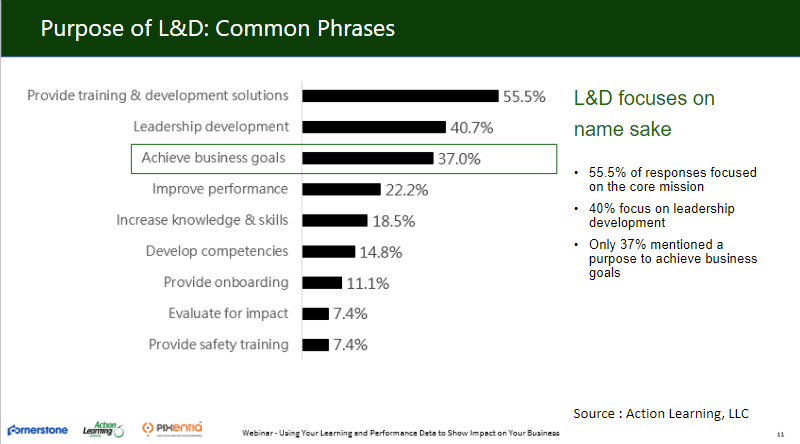If you are an L&D leader, one of your most pressing issues is probably showing the impact of what you do on business results.
For most of the learning leaders we meet, the challenge is that business leaders want the answer in value. They want to know what they are getting for their L&D spend—What's it worth?
We have had a long conversation about learning measurement for the past few decades. We have developed and used many learning evaluation models that lead us through a series of questions. One of the most popular is the Kirkpatrick model:
- How well did we satisfy the learning participants?
- Did they gain the intended knowledge, skills, attitude, confidence, and commitment?
- Do they apply what they learned on the job?
- Did we achieve the intended outcome?
The fourth question is where things fall apart because the defined outcome is usually not what excites your CEO. That makes it nearly impossible to show an impact on the business.
When we talk with L&D leaders about that measurement challenges, the conversation usually centers on three questions:
- Why should we measure the impact on the business? Isn't helping people develop and become more proficient enough?
- What should we measure?
- How can we measure it?
In this article, we will answer all three questions and give you a roadmap to answering the CEO's question—what's it worth?
Why Measure the Impact of Learning?
Doug Gray, Ph.D., Founder, and CEO of Action Learning Associates, LLC, recently spoke at a Pixentia webinar about L&D's alignment to organizational objectives. He began with the question: "What's your purpose?"
Your purpose right now might be to survive the pandemic. It could be to grow revenues in the next year by 10%. It might be to keep your family safe through the pandemic.

The problem is that when you ask L&D in most organizations what their purpose is, they usually focus on their core mission—not on business results. Doug recently partnered with John R. Mattox, II, Ph.D., Vice President of Action Learning Associates, in a survey that showed only 37% of respondents said the L&D purpose was related to achieving business goals.
Dr. Gray's point is that we are too often focused on operational objectives rather than aspirational goals. Business goals differ among industries and individual businesses, but their common theme is aspiration:
- Reduce operational costs by 8% on June 1, 2021.
- Grow sales revenue by 7% in 12 months.
- Capture 18% of the South American market by the end of 2021.
If your purpose were one of these, what would you do to achieve that purpose? How would you measure what you do?
Continue reading...
